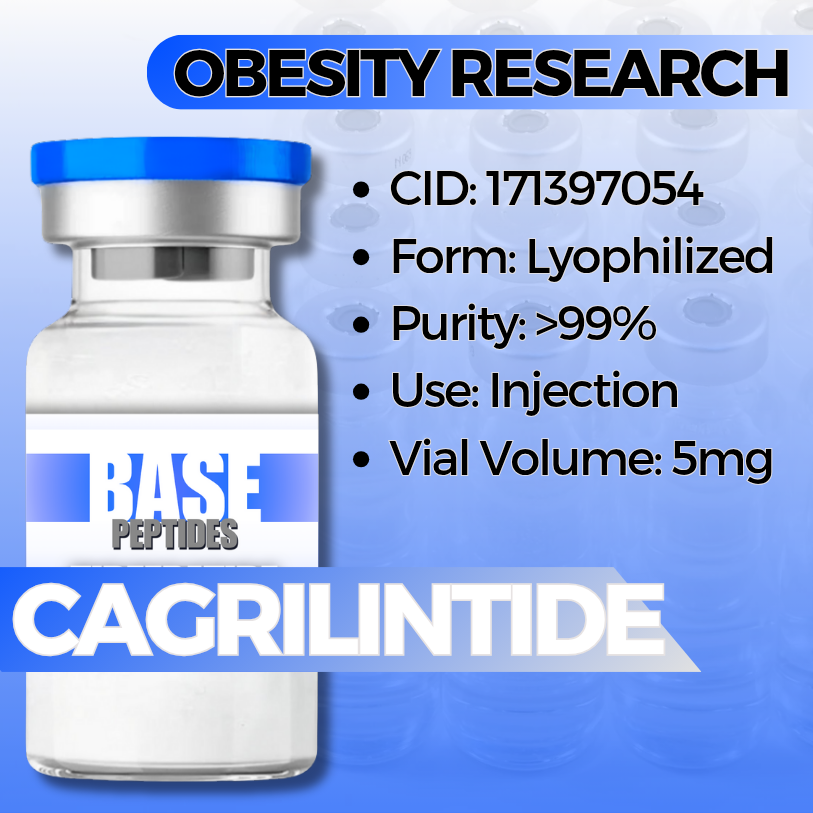Cagrilintide 5mg
Cagrilintide 5mg
Base Peptides are intended for licensed medical professionals and experienced researchers. Reconstitution required. Dosing and use instructions are not provided.
Regular price
$118.00
Regular price
Sale price
$118.00
Shipping calculated at checkout.
Quantity
Couldn't load pickup availability
Cagrilintide — Long-Acting Amylin Analogue (DACRA: Amylin/Calcitonin Receptor Agonist)
Cagrilintide is a synthetic, long-acting analogue of the naturally-occurring hormone Amylin, engineered to **activate both amylin and calcitonin-family receptors** and deliver sustained effects on appetite regulation, gastric emptying, and metabolic signalling.
Identifiers
- CAS: 1415456-99-3
- Development Codes / Synonyms: AM833, NNC0174-0833
- MW (approx): ~4,409 Da
- Mechanism Class: Dual Amylin/Calcitonin Receptor Agonist (DACRA)
How It Works (Plain English)
- Amylin is a hormone secreted alongside insulin that helps the brain sense fullness, slows stomach emptying, and blunts post-meal glucose spikes.
- Cagrilintide mimics amylin but is **modified** to last much longer and resist breakdown; it also engages calcitonin-family receptors to broaden its signalling profile.
- By acting on these receptors, it supports **reduced appetite**, **delayed gastric emptying**, and improved metabolic responses — making it valuable in obesity and type 2 diabetes.
Why Researchers Use It
- To study next-generation metabolic peptides beyond GLP-1 alone — exploring how appetite, satiety, and energy-balance pathways can be modulated via amylin signalling.
- To model **body-weight reduction**, **fat-mass change**, and metabolic health in obesity and diabetic animal or human models.
- To examine combination therapies (e.g., with GLP-1 agonists) for synergistic effects on weight and glycemic control.
Key Studies — What Was Tested, What Changed, Why It Matters
Once-weekly dose finding in overweight/obesity (Phase 2)
- What was tested: In a multicentre, randomised, double-blind, placebo-controlled dose-finding trial (weekly cagrilintide vs placebo) in people with type 2D.
- What changed: Significant reductions in body weight — with tolerable safety profiles (gastrointestinal side-effects were the most common)
- Why it matters: Demonstrates that amylin-receptor targeting peptides can produce meaningful weight loss, supporting further research in metabolic disease.
Cagrilintide + GLP-1 (Semaglutide) in Obesity + T2D (Phase 3a)
- What was tested: Adults with overweight/obesity and type 2 diabetes assigned to once-weekly cagrilintide + Semaglutide 2.4 mg or placebo for 68 weeks.
- What changed: Mean weight change ~-13.7 % in the combination group vs -3.4 % in placebo during the study period.
- Why it matters: Highlights that combining amylin-pathway peptides with GLP-1 may enhance weight & metabolic outcomes — central to research strategies.
Potential Research Applications
Obesity & Weight-Management Models
- Animal or human models of diet-induced obesity, body-composition tracking (fat vs lean change).
- Appetite/feeding behaviour, satiety readouts, gastric-emptying studies.
Type 2 Diabetes & Metabolic Syndrome
- Glucose tolerance tests, HbA1c reduction, insulin-secretion/insulin-sensitivity assays.
- Combination therapies exploration.
Energy Balance & Gastrointestinal Dynamics
- Gastric-emptying delay, food-intake measurement, brain satiety signalling (hypothalamus, area postrema).
- Cross-talk between pancreatic hormones (insulin, amylin) and central regulators.
Synergistic Peptides (for Study Design)
Semaglutide
- Why pair: A GLP-1 receptor agonist with well-established weight-loss and glycaemic control effects; pairing with cagrilintide leverages **different but complementary pathways** (amylin + GLP-1).
- Angle: Design head-to-head or additive studies to test whether amylin-pathway activation adds benefit to GLP-1 alone.
Retatrutide
- Why pair: A triple-agonist peptide (GLP-1/GIP/glucagon) that expands metabolic mechanism space; combining with an amylin analog may enhance energy-balance readouts.
- Angle: Multi-agonist designs exploring satiety + caloric-burn + insulin responses simultaneously.
MOTS-c
- Why pair: A mitochondrial-derived peptide influencing energy-metabolism; useful in designs where weight-loss interventions include mitochondrial/energy-burn endpoints.
- Angle: Combine feeding/appetite suppression (cagrilintide) with mitochondrial function metrics (MOTS-c) for comprehensive metabolic studies.
Design Notes
- Specify dosing frequency (once-weekly), vehicle, salt/acetylation form; amylin analogues are sensitive to amyloid-/aggregation potential.
- Ensure baseline diet/exercise control in models—appetite suppression may interact with behavioural confounds.
Known Concerns (Context)
- Gastrointestinal side-effects: In human trials nausea, constipation, diarrhea were more frequent compared to Semaglutide.
- Long-term human safety: Although promising, long-term data (especially beyond 2-3 years) remain limited; careful translation.
- General: Research-use only; not approved for therapeutic use in many jurisdictions. Buyer must ensure proper handling and compliance.
Specifications & Handling
- Form: Lyophilised powder (lot-coded) — verify salt/acylation form.
- Purity: Typically ≥ 99 % (HPLC-verified) in research grade. 3
- Storage: ≤ −20 °C; protect from light/moisture; minimise freeze–thaw cycles.
- In solution: Prepare fresh aliquots; record vehicle pH, temperature, and tube type.
- Packaging: Tamper-evident; labelled “research-use only” where required.
Regulatory & Use Notice
Sold for laboratory research use only. Not for human consumption, medical, or veterinary use. No human-use instructions are provided. Buyer is responsible for safe handling and regulatory compliance.
Cagrilintide Amylin Analogue Peptide Research | Dual Amylin/Calcitonin Receptor Agonist | Obesity & Metabolic Syndrome Studies


